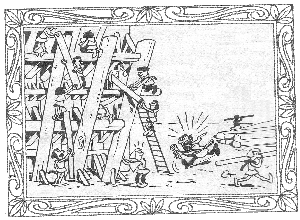|
 Among the very few remaining examples of framing in the Middle Ages, the Tapestries of Bayeux (Queen Mathilde) are adorned with embroidered frames representing ornamental or animal or narrative topics. The most famous depicts the building of the first Roman Church of Chécy (of which, unfortunately, only the steeple remains to this day). Among the very few remaining examples of framing in the Middle Ages, the Tapestries of Bayeux (Queen Mathilde) are adorned with embroidered frames representing ornamental or animal or narrative topics. The most famous depicts the building of the first Roman Church of Chécy (of which, unfortunately, only the steeple remains to this day).
Watching a young girl from Lorraine in the activity of painting a landscape on the banks of the Loire in the spring of 1429, Leon Battista Alberti discovered something he would not fail to record later for the posterity, in his Treaty della Pittura : “Painting is like a window opening on a real world, there is a need to demarcate at first its outline. Thus, the frame acts as a signal towards the viewer, telling him he is facing a work of art and not the real world.” Otherwise, how could he know it ?
“Bordures” as they were called in old French in the 17th and 18th century have survived to our time. Strongly architectural in Middle-Ages and Renaissance they became darker in the 18th Century ( being mostly made of wood or tortoiseshell), then dried putty and cast plaster of Paris followed in the 19th Century.
Modern frames are now more restrained or plainly non-existent (and nobody will complain ! )
The art of framing is to learn how to enhance the artistic value of a painting or a picture by surrounding it with a chamfered edge of any of the following types : (A l'anglaise, Octagonal, Fancy, Parrot or Crazy )
The bevelled edge could be upholstered or cut with jig-saw openings, its linings being either, carved, stairshaped or with worked comers....
The whole business being, of course, surrounded by a long and narrow piece of wood or metal. called as you have guessed by now : framing
|